Advance Diploma in Accounting Project Report: FNS60215
VerifiedAdded on 2022/12/26
|20
|3220
|81
Project
AI Summary
This project report, prepared for an Advanced Diploma in Accounting, delves into financial statistics and their application. Part A covers sampling methods, statistical standards, modeling, and various analytical tools like measures of frequency, central tendency, and ratio analysis. It examines sources of financial information and statistical data from the Australian Bureau of Statistics (ABS) and Reserve Bank of Australia (RBA). The report includes data representation through tables and graphs, demonstrating calculations and interpretations. Part B focuses on a case study of J W Pty Ltd, employing ratio analysis to assess the company's financial performance. It explores the roles of regulatory bodies like ATO, APRA, RBA, ABS, and ASIC. The report uses annual and internal reports for data collection, along with graphical representations and calculations, to illustrate sales growth, staff numbers, and other relevant financial metrics.
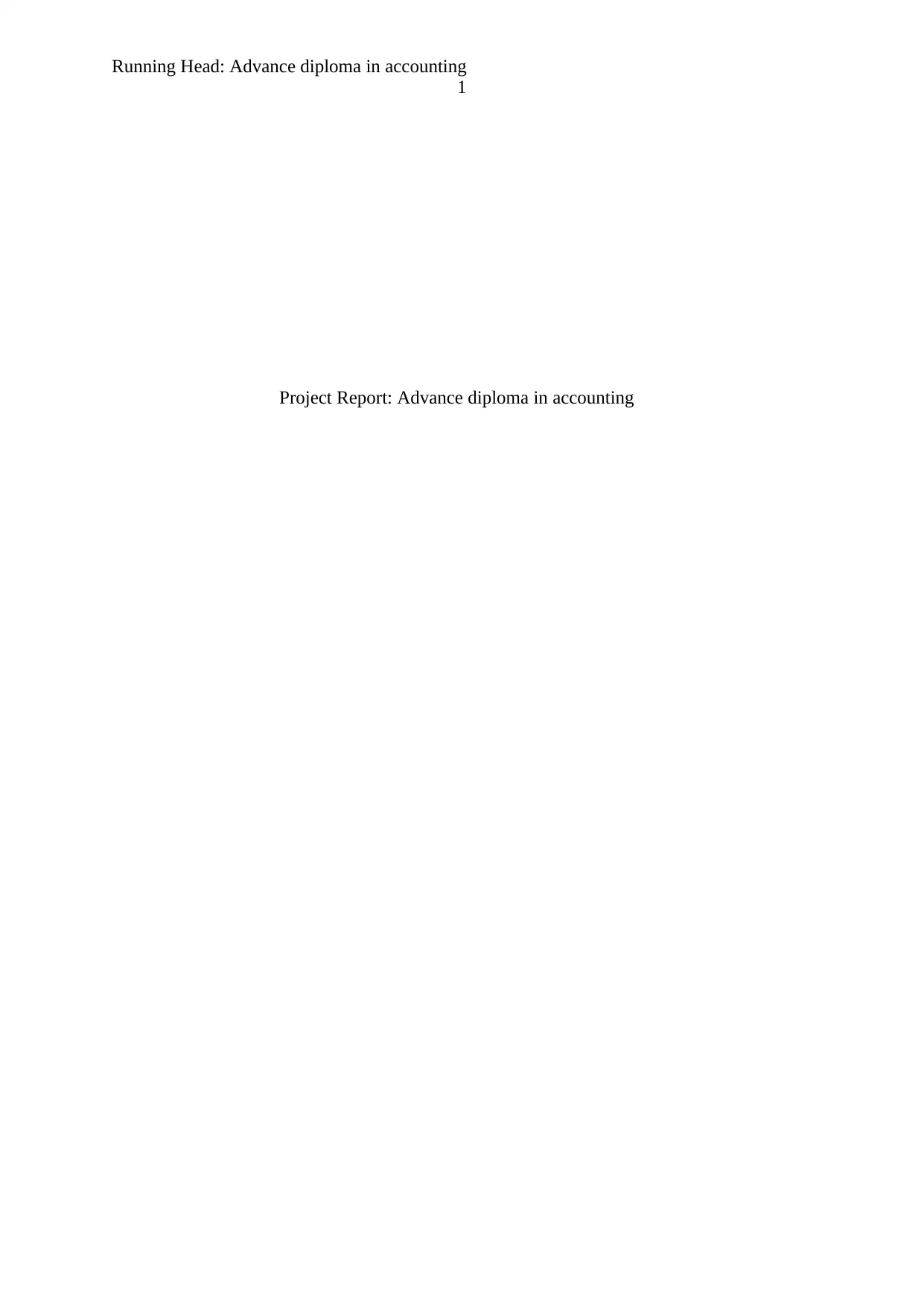
Running Head: Advance diploma in accounting
1
Project Report: Advance diploma in accounting
1
Project Report: Advance diploma in accounting
Paraphrase This Document
Need a fresh take? Get an instant paraphrase of this document with our AI Paraphraser
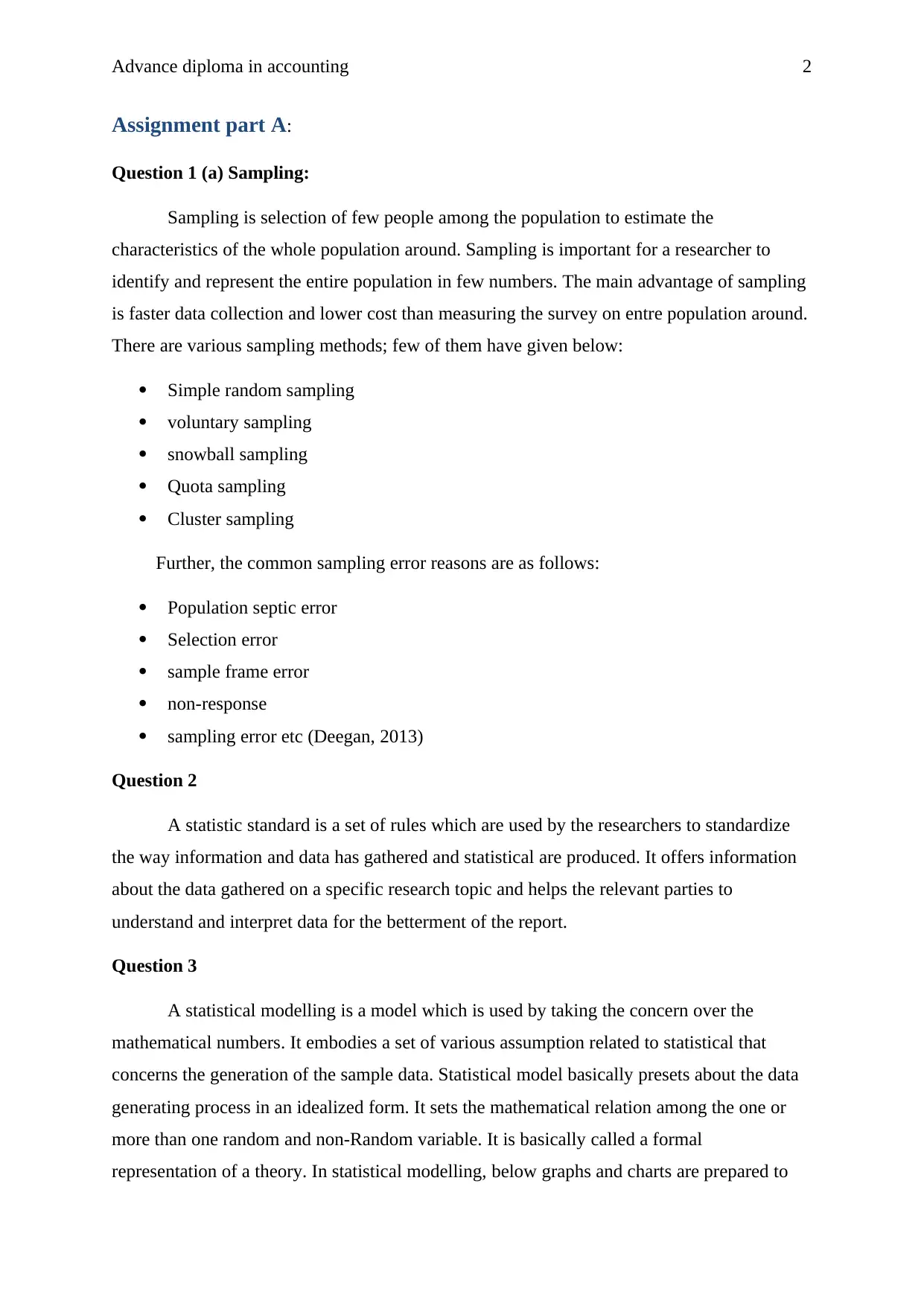
Advance diploma in accounting 2
Assignment part A:
Question 1 (a) Sampling:
Sampling is selection of few people among the population to estimate the
characteristics of the whole population around. Sampling is important for a researcher to
identify and represent the entire population in few numbers. The main advantage of sampling
is faster data collection and lower cost than measuring the survey on entre population around.
There are various sampling methods; few of them have given below:
Simple random sampling
voluntary sampling
snowball sampling
Quota sampling
Cluster sampling
Further, the common sampling error reasons are as follows:
Population septic error
Selection error
sample frame error
non-response
sampling error etc (Deegan, 2013)
Question 2
A statistic standard is a set of rules which are used by the researchers to standardize
the way information and data has gathered and statistical are produced. It offers information
about the data gathered on a specific research topic and helps the relevant parties to
understand and interpret data for the betterment of the report.
Question 3
A statistical modelling is a model which is used by taking the concern over the
mathematical numbers. It embodies a set of various assumption related to statistical that
concerns the generation of the sample data. Statistical model basically presets about the data
generating process in an idealized form. It sets the mathematical relation among the one or
more than one random and non-Random variable. It is basically called a formal
representation of a theory. In statistical modelling, below graphs and charts are prepared to
Assignment part A:
Question 1 (a) Sampling:
Sampling is selection of few people among the population to estimate the
characteristics of the whole population around. Sampling is important for a researcher to
identify and represent the entire population in few numbers. The main advantage of sampling
is faster data collection and lower cost than measuring the survey on entre population around.
There are various sampling methods; few of them have given below:
Simple random sampling
voluntary sampling
snowball sampling
Quota sampling
Cluster sampling
Further, the common sampling error reasons are as follows:
Population septic error
Selection error
sample frame error
non-response
sampling error etc (Deegan, 2013)
Question 2
A statistic standard is a set of rules which are used by the researchers to standardize
the way information and data has gathered and statistical are produced. It offers information
about the data gathered on a specific research topic and helps the relevant parties to
understand and interpret data for the betterment of the report.
Question 3
A statistical modelling is a model which is used by taking the concern over the
mathematical numbers. It embodies a set of various assumption related to statistical that
concerns the generation of the sample data. Statistical model basically presets about the data
generating process in an idealized form. It sets the mathematical relation among the one or
more than one random and non-Random variable. It is basically called a formal
representation of a theory. In statistical modelling, below graphs and charts are prepared to
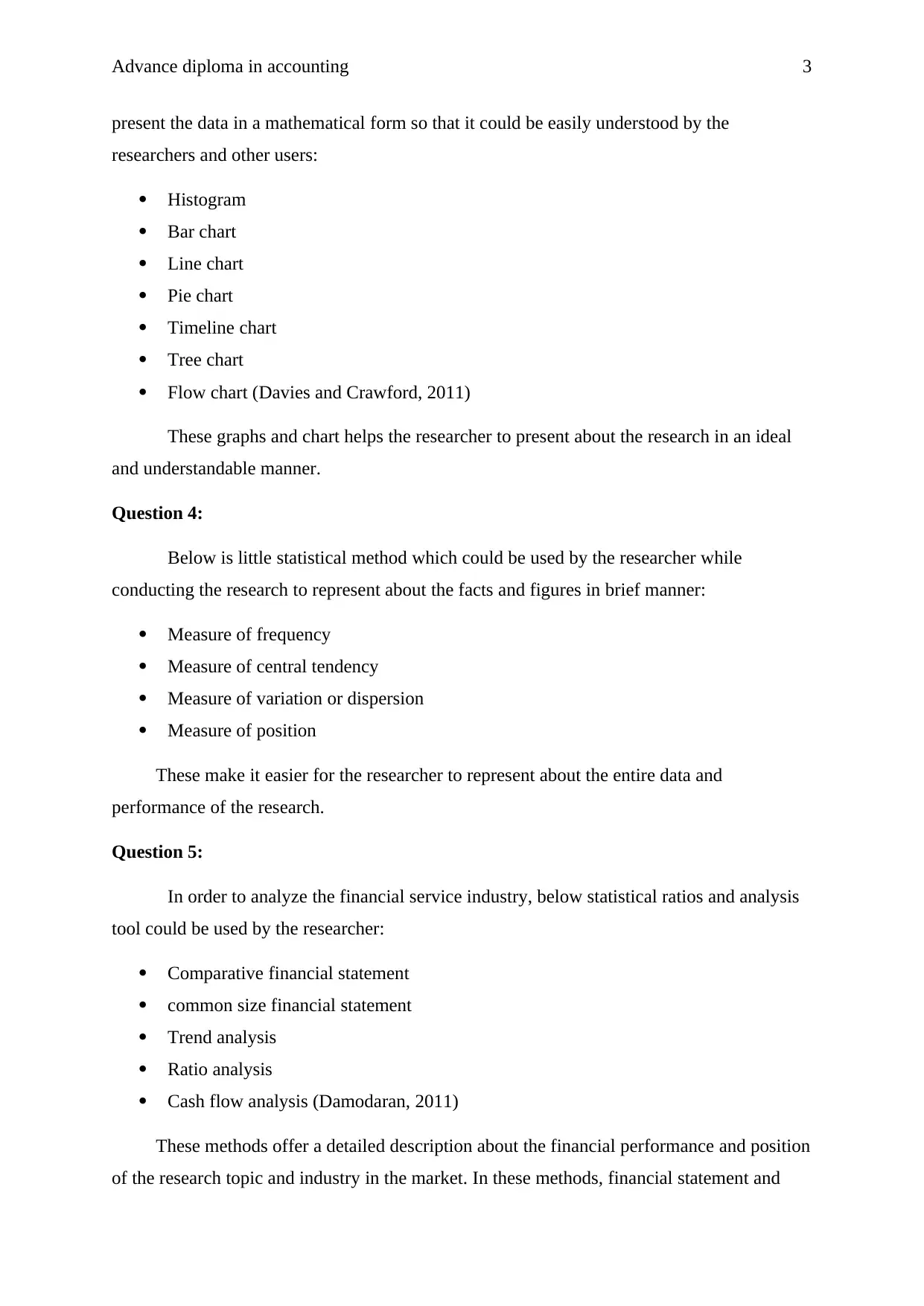
Advance diploma in accounting 3
present the data in a mathematical form so that it could be easily understood by the
researchers and other users:
Histogram
Bar chart
Line chart
Pie chart
Timeline chart
Tree chart
Flow chart (Davies and Crawford, 2011)
These graphs and chart helps the researcher to present about the research in an ideal
and understandable manner.
Question 4:
Below is little statistical method which could be used by the researcher while
conducting the research to represent about the facts and figures in brief manner:
Measure of frequency
Measure of central tendency
Measure of variation or dispersion
Measure of position
These make it easier for the researcher to represent about the entire data and
performance of the research.
Question 5:
In order to analyze the financial service industry, below statistical ratios and analysis
tool could be used by the researcher:
Comparative financial statement
common size financial statement
Trend analysis
Ratio analysis
Cash flow analysis (Damodaran, 2011)
These methods offer a detailed description about the financial performance and position
of the research topic and industry in the market. In these methods, financial statement and
present the data in a mathematical form so that it could be easily understood by the
researchers and other users:
Histogram
Bar chart
Line chart
Pie chart
Timeline chart
Tree chart
Flow chart (Davies and Crawford, 2011)
These graphs and chart helps the researcher to present about the research in an ideal
and understandable manner.
Question 4:
Below is little statistical method which could be used by the researcher while
conducting the research to represent about the facts and figures in brief manner:
Measure of frequency
Measure of central tendency
Measure of variation or dispersion
Measure of position
These make it easier for the researcher to represent about the entire data and
performance of the research.
Question 5:
In order to analyze the financial service industry, below statistical ratios and analysis
tool could be used by the researcher:
Comparative financial statement
common size financial statement
Trend analysis
Ratio analysis
Cash flow analysis (Damodaran, 2011)
These methods offer a detailed description about the financial performance and position
of the research topic and industry in the market. In these methods, financial statement and
⊘ This is a preview!⊘
Do you want full access?
Subscribe today to unlock all pages.

Trusted by 1+ million students worldwide
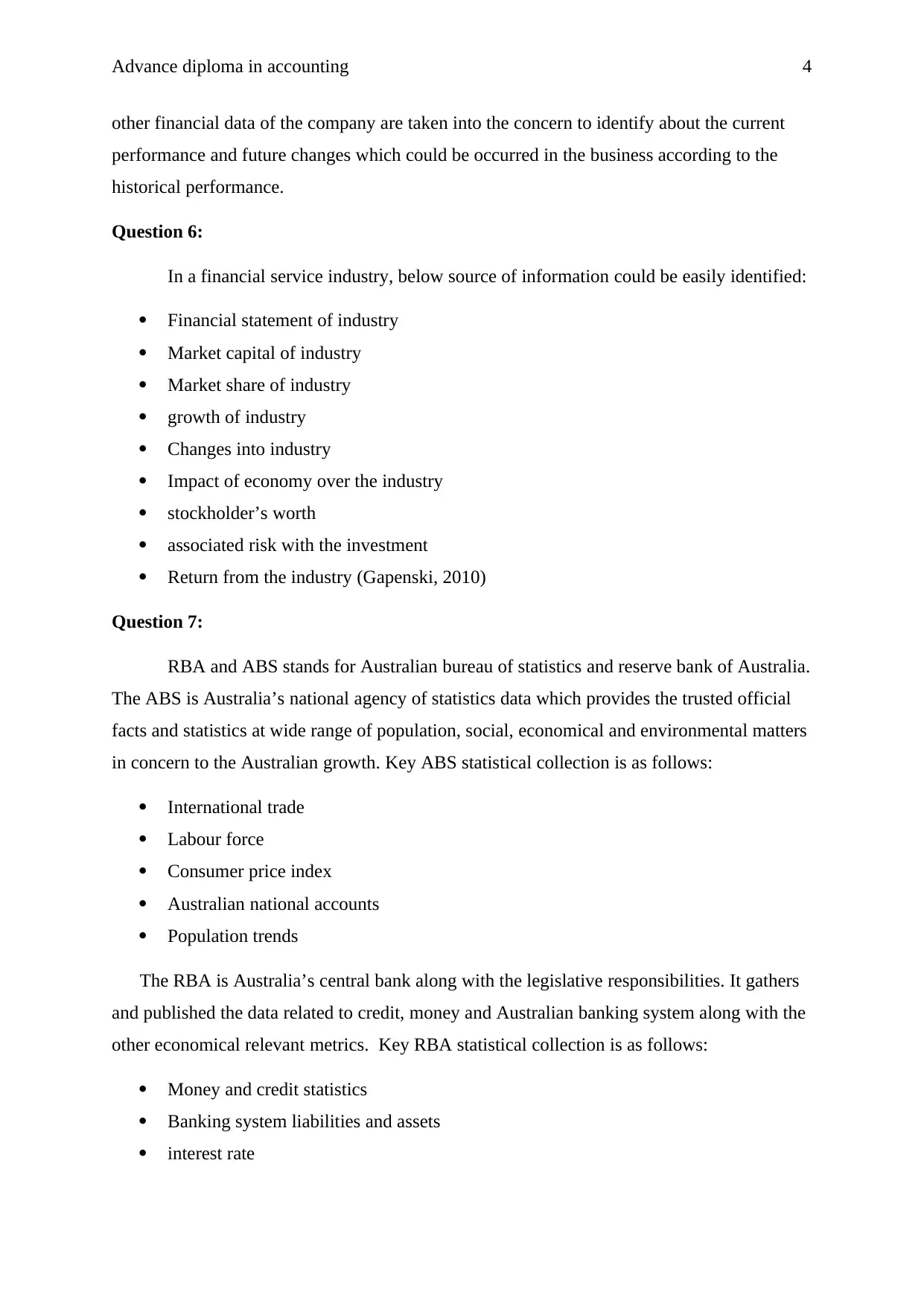
Advance diploma in accounting 4
other financial data of the company are taken into the concern to identify about the current
performance and future changes which could be occurred in the business according to the
historical performance.
Question 6:
In a financial service industry, below source of information could be easily identified:
Financial statement of industry
Market capital of industry
Market share of industry
growth of industry
Changes into industry
Impact of economy over the industry
stockholder’s worth
associated risk with the investment
Return from the industry (Gapenski, 2010)
Question 7:
RBA and ABS stands for Australian bureau of statistics and reserve bank of Australia.
The ABS is Australia’s national agency of statistics data which provides the trusted official
facts and statistics at wide range of population, social, economical and environmental matters
in concern to the Australian growth. Key ABS statistical collection is as follows:
International trade
Labour force
Consumer price index
Australian national accounts
Population trends
The RBA is Australia’s central bank along with the legislative responsibilities. It gathers
and published the data related to credit, money and Australian banking system along with the
other economical relevant metrics. Key RBA statistical collection is as follows:
Money and credit statistics
Banking system liabilities and assets
interest rate
other financial data of the company are taken into the concern to identify about the current
performance and future changes which could be occurred in the business according to the
historical performance.
Question 6:
In a financial service industry, below source of information could be easily identified:
Financial statement of industry
Market capital of industry
Market share of industry
growth of industry
Changes into industry
Impact of economy over the industry
stockholder’s worth
associated risk with the investment
Return from the industry (Gapenski, 2010)
Question 7:
RBA and ABS stands for Australian bureau of statistics and reserve bank of Australia.
The ABS is Australia’s national agency of statistics data which provides the trusted official
facts and statistics at wide range of population, social, economical and environmental matters
in concern to the Australian growth. Key ABS statistical collection is as follows:
International trade
Labour force
Consumer price index
Australian national accounts
Population trends
The RBA is Australia’s central bank along with the legislative responsibilities. It gathers
and published the data related to credit, money and Australian banking system along with the
other economical relevant metrics. Key RBA statistical collection is as follows:
Money and credit statistics
Banking system liabilities and assets
interest rate
Paraphrase This Document
Need a fresh take? Get an instant paraphrase of this document with our AI Paraphraser
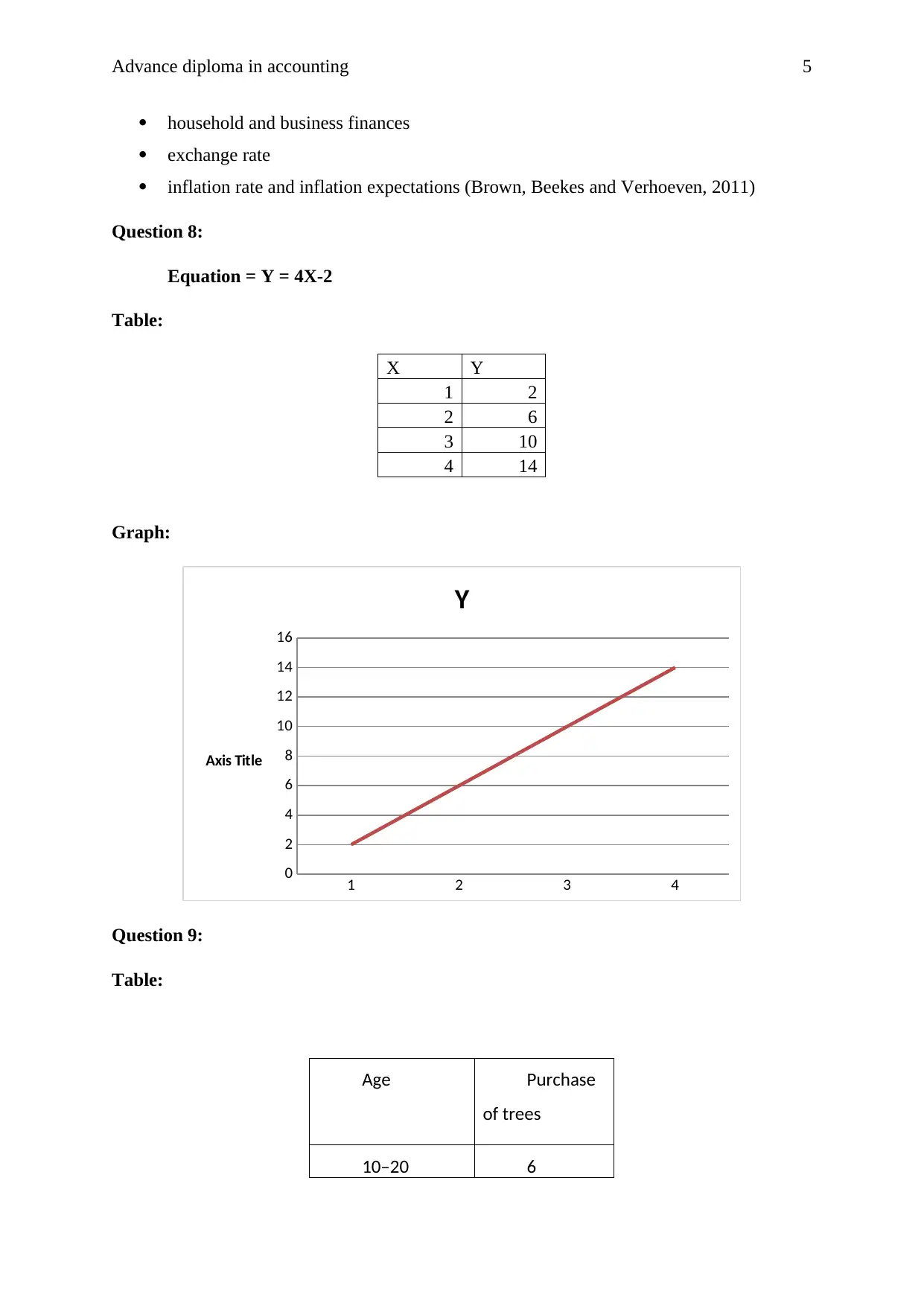
Advance diploma in accounting 5
household and business finances
exchange rate
inflation rate and inflation expectations (Brown, Beekes and Verhoeven, 2011)
Question 8:
Equation = Y = 4X-2
Table:
X Y
1 2
2 6
3 10
4 14
Graph:
1 2 3 4
0
2
4
6
8
10
12
14
16
Y
Axis Title
Question 9:
Table:
Age Purchase
of trees
10–20 6
household and business finances
exchange rate
inflation rate and inflation expectations (Brown, Beekes and Verhoeven, 2011)
Question 8:
Equation = Y = 4X-2
Table:
X Y
1 2
2 6
3 10
4 14
Graph:
1 2 3 4
0
2
4
6
8
10
12
14
16
Y
Axis Title
Question 9:
Table:
Age Purchase
of trees
10–20 6
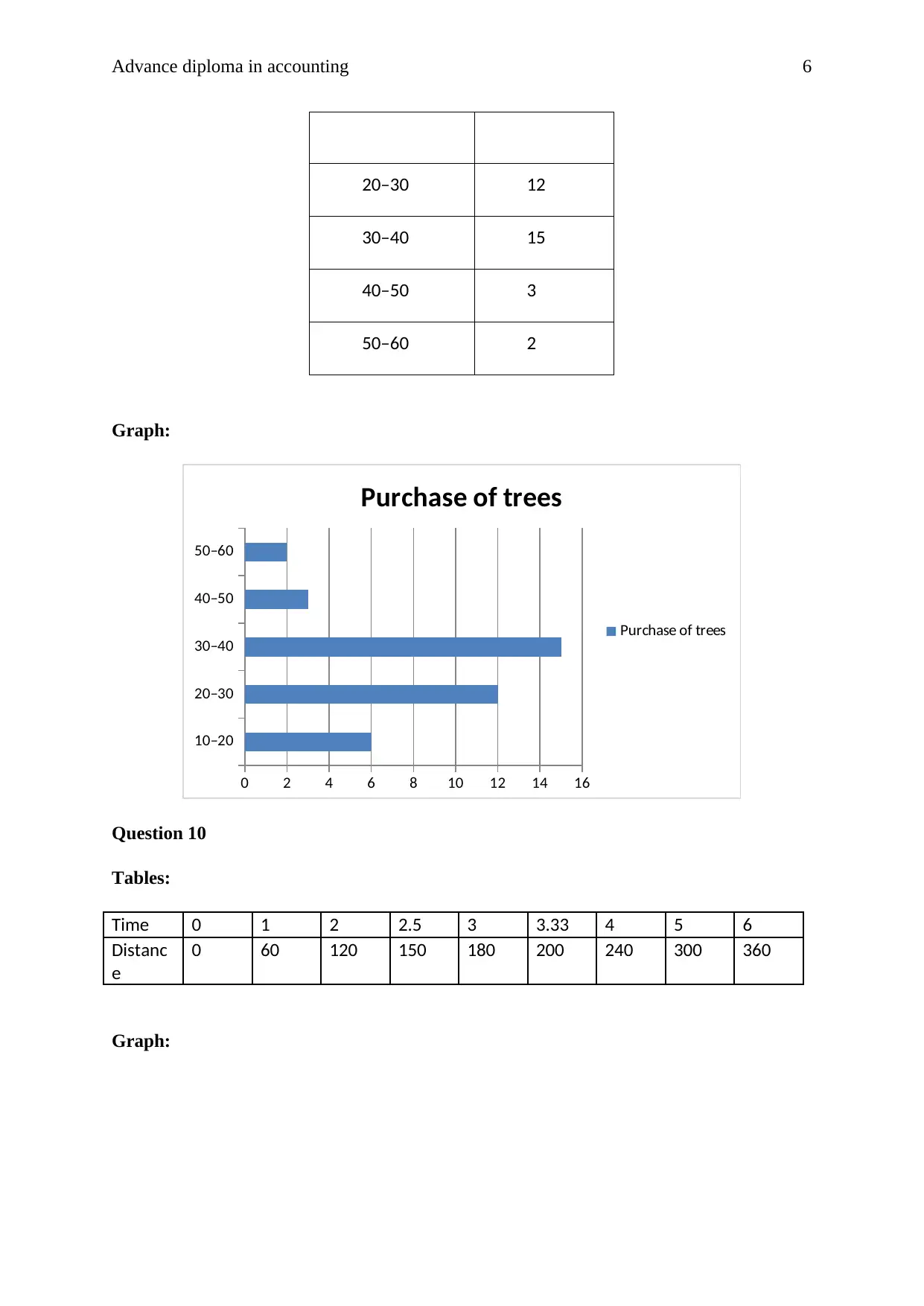
Advance diploma in accounting 6
20–30 12
30–40 15
40–50 3
50–60 2
Graph:
10–20
20–30
30–40
40–50
50–60
0 2 4 6 8 10 12 14 16
Purchase of trees
Purchase of trees
Question 10
Tables:
Time 0 1 2 2.5 3 3.33 4 5 6
Distanc
e
0 60 120 150 180 200 240 300 360
Graph:
20–30 12
30–40 15
40–50 3
50–60 2
Graph:
10–20
20–30
30–40
40–50
50–60
0 2 4 6 8 10 12 14 16
Purchase of trees
Purchase of trees
Question 10
Tables:
Time 0 1 2 2.5 3 3.33 4 5 6
Distanc
e
0 60 120 150 180 200 240 300 360
Graph:
⊘ This is a preview!⊘
Do you want full access?
Subscribe today to unlock all pages.

Trusted by 1+ million students worldwide
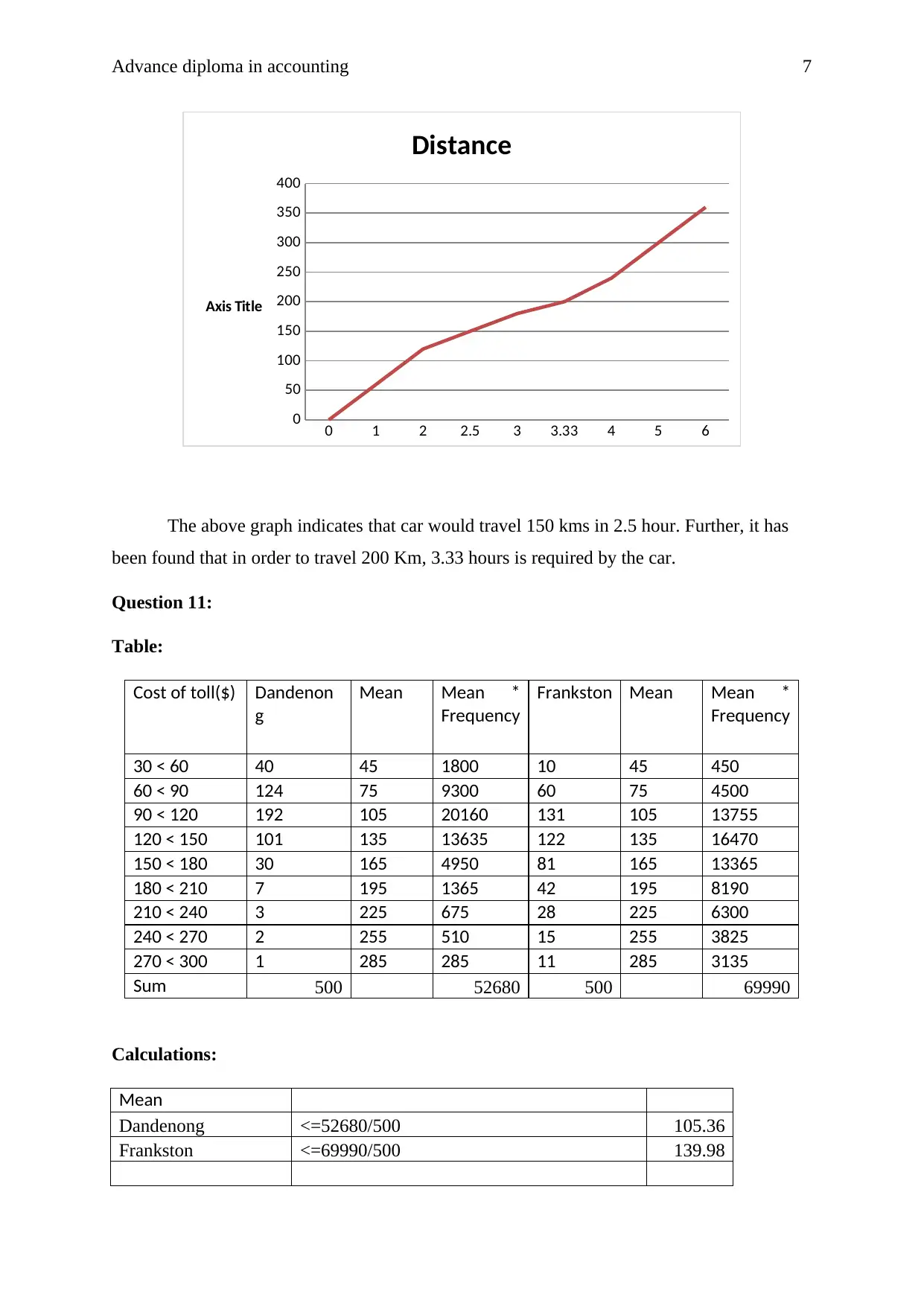
Advance diploma in accounting 7
0 1 2 2.5 3 3.33 4 5 6
0
50
100
150
200
250
300
350
400
Distance
Axis Title
The above graph indicates that car would travel 150 kms in 2.5 hour. Further, it has
been found that in order to travel 200 Km, 3.33 hours is required by the car.
Question 11:
Table:
Cost of toll($) Dandenon
g
Mean Mean *
Frequency
Frankston Mean Mean *
Frequency
30 < 60 40 45 1800 10 45 450
60 < 90 124 75 9300 60 75 4500
90 < 120 192 105 20160 131 105 13755
120 < 150 101 135 13635 122 135 16470
150 < 180 30 165 4950 81 165 13365
180 < 210 7 195 1365 42 195 8190
210 < 240 3 225 675 28 225 6300
240 < 270 2 255 510 15 255 3825
270 < 300 1 285 285 11 285 3135
Sum 500 52680 500 69990
Calculations:
Mean
Dandenong <=52680/500 105.36
Frankston <=69990/500 139.98
0 1 2 2.5 3 3.33 4 5 6
0
50
100
150
200
250
300
350
400
Distance
Axis Title
The above graph indicates that car would travel 150 kms in 2.5 hour. Further, it has
been found that in order to travel 200 Km, 3.33 hours is required by the car.
Question 11:
Table:
Cost of toll($) Dandenon
g
Mean Mean *
Frequency
Frankston Mean Mean *
Frequency
30 < 60 40 45 1800 10 45 450
60 < 90 124 75 9300 60 75 4500
90 < 120 192 105 20160 131 105 13755
120 < 150 101 135 13635 122 135 16470
150 < 180 30 165 4950 81 165 13365
180 < 210 7 195 1365 42 195 8190
210 < 240 3 225 675 28 225 6300
240 < 270 2 255 510 15 255 3825
270 < 300 1 285 285 11 285 3135
Sum 500 52680 500 69990
Calculations:
Mean
Dandenong <=52680/500 105.36
Frankston <=69990/500 139.98
Paraphrase This Document
Need a fresh take? Get an instant paraphrase of this document with our AI Paraphraser
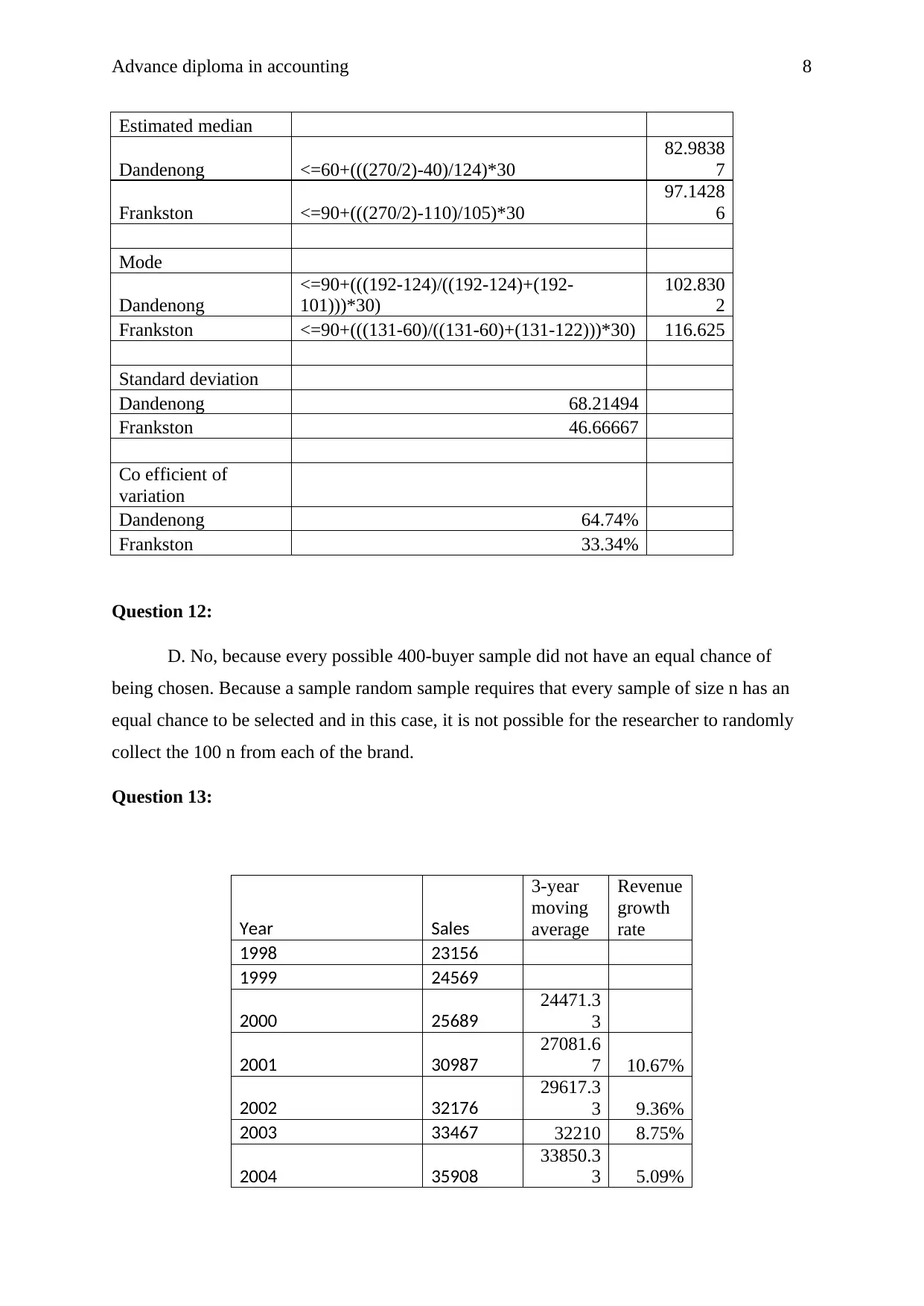
Advance diploma in accounting 8
Estimated median
Dandenong <=60+(((270/2)-40)/124)*30
82.9838
7
Frankston <=90+(((270/2)-110)/105)*30
97.1428
6
Mode
Dandenong
<=90+(((192-124)/((192-124)+(192-
101)))*30)
102.830
2
Frankston <=90+(((131-60)/((131-60)+(131-122)))*30) 116.625
Standard deviation
Dandenong 68.21494
Frankston 46.66667
Co efficient of
variation
Dandenong 64.74%
Frankston 33.34%
Question 12:
D. No, because every possible 400-buyer sample did not have an equal chance of
being chosen. Because a sample random sample requires that every sample of size n has an
equal chance to be selected and in this case, it is not possible for the researcher to randomly
collect the 100 n from each of the brand.
Question 13:
Year Sales
3-year
moving
average
Revenue
growth
rate
1998 23156
1999 24569
2000 25689
24471.3
3
2001 30987
27081.6
7 10.67%
2002 32176
29617.3
3 9.36%
2003 33467 32210 8.75%
2004 35908
33850.3
3 5.09%
Estimated median
Dandenong <=60+(((270/2)-40)/124)*30
82.9838
7
Frankston <=90+(((270/2)-110)/105)*30
97.1428
6
Mode
Dandenong
<=90+(((192-124)/((192-124)+(192-
101)))*30)
102.830
2
Frankston <=90+(((131-60)/((131-60)+(131-122)))*30) 116.625
Standard deviation
Dandenong 68.21494
Frankston 46.66667
Co efficient of
variation
Dandenong 64.74%
Frankston 33.34%
Question 12:
D. No, because every possible 400-buyer sample did not have an equal chance of
being chosen. Because a sample random sample requires that every sample of size n has an
equal chance to be selected and in this case, it is not possible for the researcher to randomly
collect the 100 n from each of the brand.
Question 13:
Year Sales
3-year
moving
average
Revenue
growth
rate
1998 23156
1999 24569
2000 25689
24471.3
3
2001 30987
27081.6
7 10.67%
2002 32176
29617.3
3 9.36%
2003 33467 32210 8.75%
2004 35908
33850.3
3 5.09%
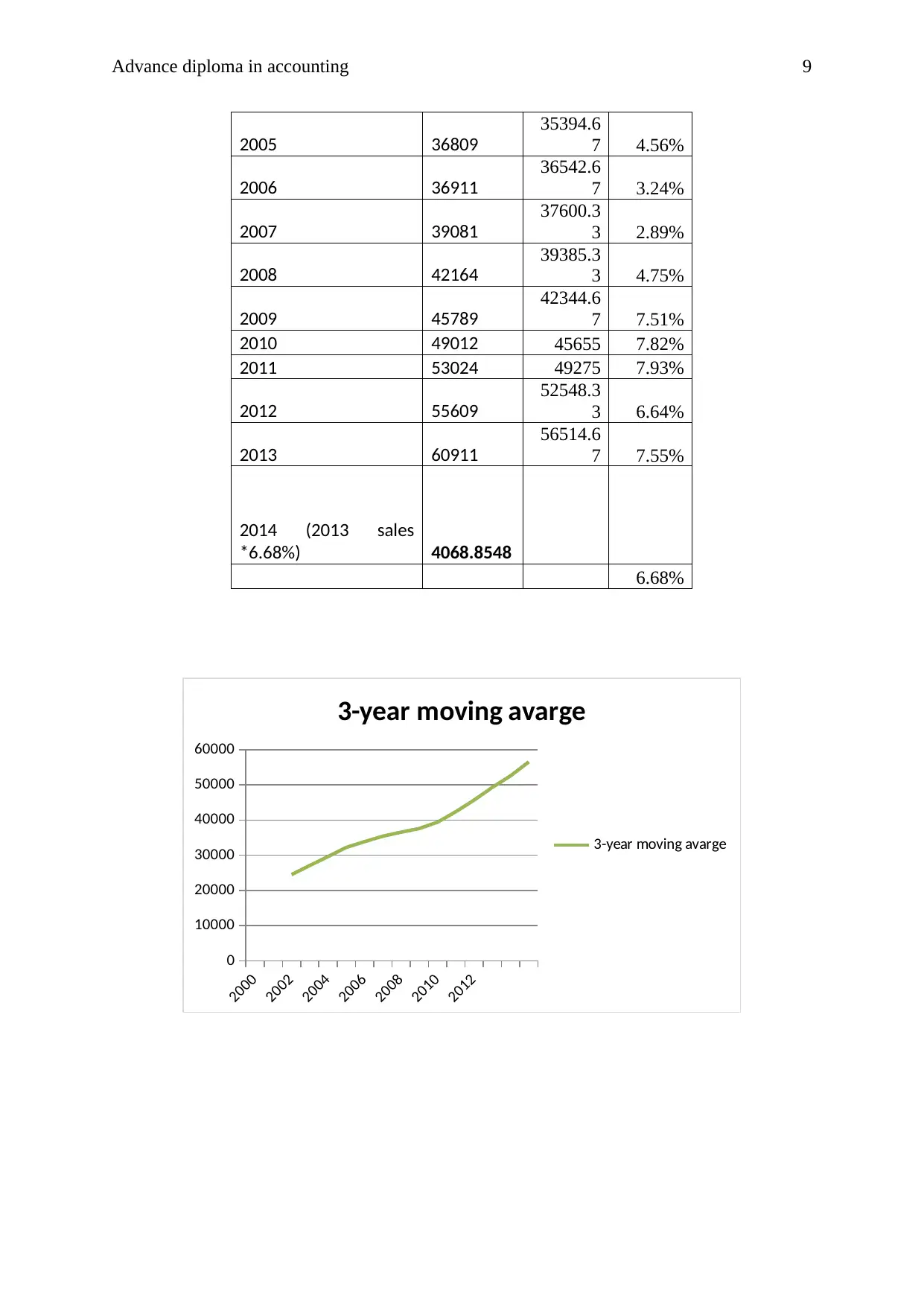
Advance diploma in accounting 9
2005 36809
35394.6
7 4.56%
2006 36911
36542.6
7 3.24%
2007 39081
37600.3
3 2.89%
2008 42164
39385.3
3 4.75%
2009 45789
42344.6
7 7.51%
2010 49012 45655 7.82%
2011 53024 49275 7.93%
2012 55609
52548.3
3 6.64%
2013 60911
56514.6
7 7.55%
2014 (2013 sales
*6.68%) 4068.8548
6.68%
2000
2002
2004
2006
2008
2010
2012
0
10000
20000
30000
40000
50000
60000
3-year moving avarge
3-year moving avarge
2005 36809
35394.6
7 4.56%
2006 36911
36542.6
7 3.24%
2007 39081
37600.3
3 2.89%
2008 42164
39385.3
3 4.75%
2009 45789
42344.6
7 7.51%
2010 49012 45655 7.82%
2011 53024 49275 7.93%
2012 55609
52548.3
3 6.64%
2013 60911
56514.6
7 7.55%
2014 (2013 sales
*6.68%) 4068.8548
6.68%
2000
2002
2004
2006
2008
2010
2012
0
10000
20000
30000
40000
50000
60000
3-year moving avarge
3-year moving avarge
⊘ This is a preview!⊘
Do you want full access?
Subscribe today to unlock all pages.

Trusted by 1+ million students worldwide
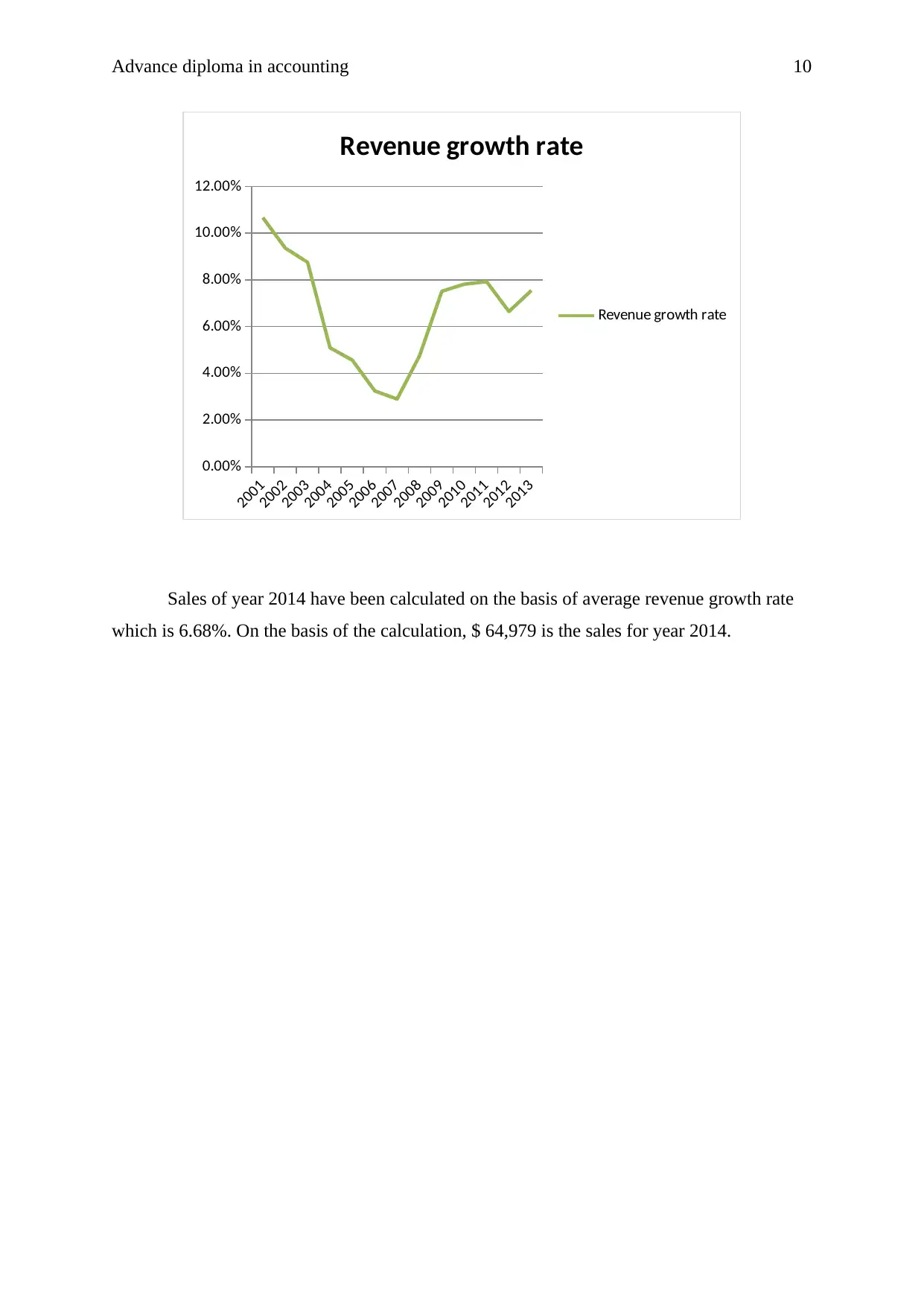
Advance diploma in accounting 10
2001
2002
2003
2004
2005
2006
2007
2008
2009
2010
2011
2012
2013
0.00%
2.00%
4.00%
6.00%
8.00%
10.00%
12.00%
Revenue growth rate
Revenue growth rate
Sales of year 2014 have been calculated on the basis of average revenue growth rate
which is 6.68%. On the basis of the calculation, $ 64,979 is the sales for year 2014.
2001
2002
2003
2004
2005
2006
2007
2008
2009
2010
2011
2012
2013
0.00%
2.00%
4.00%
6.00%
8.00%
10.00%
12.00%
Revenue growth rate
Revenue growth rate
Sales of year 2014 have been calculated on the basis of average revenue growth rate
which is 6.68%. On the basis of the calculation, $ 64,979 is the sales for year 2014.
Paraphrase This Document
Need a fresh take? Get an instant paraphrase of this document with our AI Paraphraser
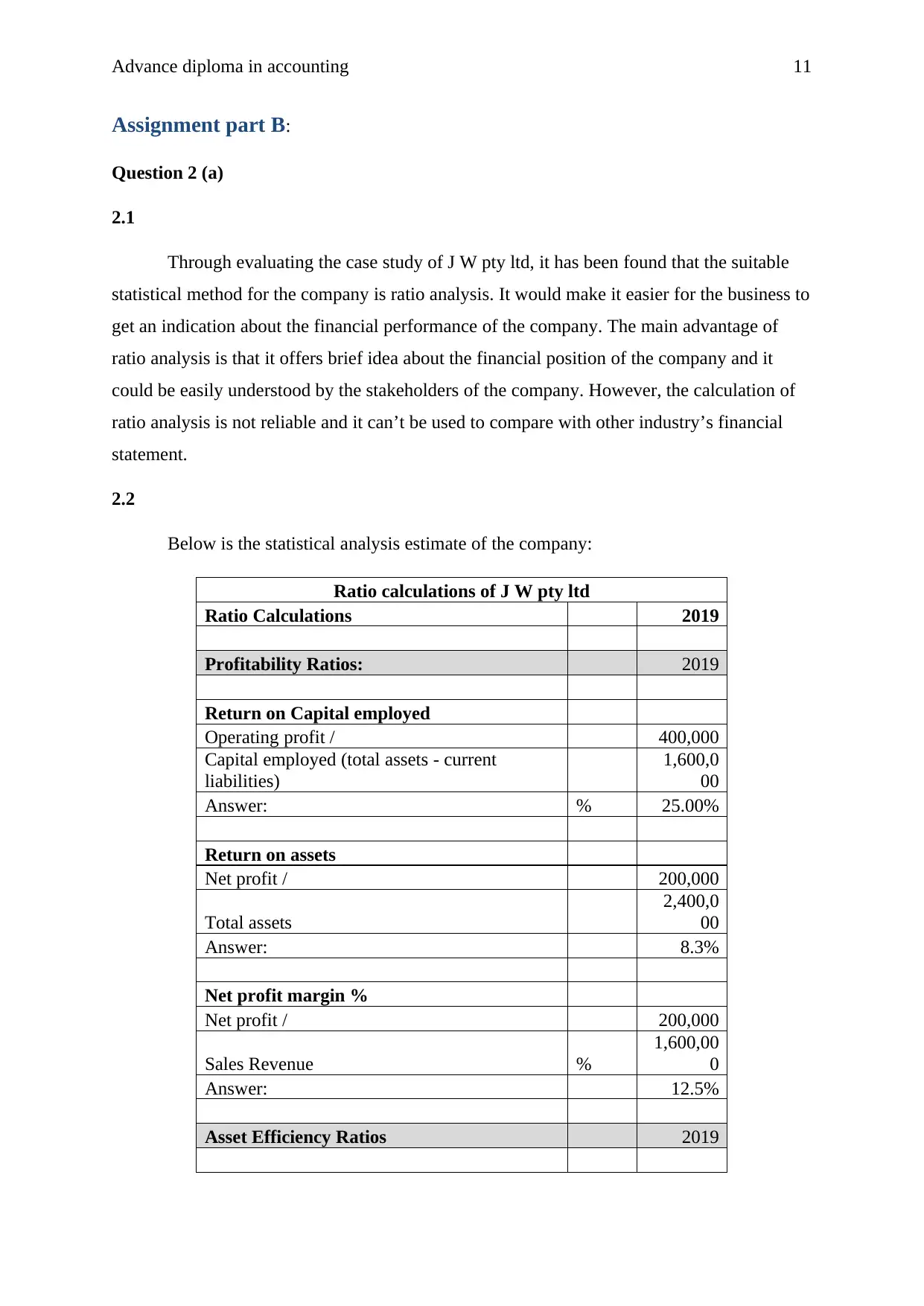
Advance diploma in accounting 11
Assignment part B:
Question 2 (a)
2.1
Through evaluating the case study of J W pty ltd, it has been found that the suitable
statistical method for the company is ratio analysis. It would make it easier for the business to
get an indication about the financial performance of the company. The main advantage of
ratio analysis is that it offers brief idea about the financial position of the company and it
could be easily understood by the stakeholders of the company. However, the calculation of
ratio analysis is not reliable and it can’t be used to compare with other industry’s financial
statement.
2.2
Below is the statistical analysis estimate of the company:
Ratio calculations of J W pty ltd
Ratio Calculations 2019
Profitability Ratios: 2019
Return on Capital employed
Operating profit / 400,000
Capital employed (total assets - current
liabilities)
1,600,0
00
Answer: % 25.00%
Return on assets
Net profit / 200,000
Total assets
2,400,0
00
Answer: 8.3%
Net profit margin %
Net profit / 200,000
Sales Revenue %
1,600,00
0
Answer: 12.5%
Asset Efficiency Ratios 2019
Assignment part B:
Question 2 (a)
2.1
Through evaluating the case study of J W pty ltd, it has been found that the suitable
statistical method for the company is ratio analysis. It would make it easier for the business to
get an indication about the financial performance of the company. The main advantage of
ratio analysis is that it offers brief idea about the financial position of the company and it
could be easily understood by the stakeholders of the company. However, the calculation of
ratio analysis is not reliable and it can’t be used to compare with other industry’s financial
statement.
2.2
Below is the statistical analysis estimate of the company:
Ratio calculations of J W pty ltd
Ratio Calculations 2019
Profitability Ratios: 2019
Return on Capital employed
Operating profit / 400,000
Capital employed (total assets - current
liabilities)
1,600,0
00
Answer: % 25.00%
Return on assets
Net profit / 200,000
Total assets
2,400,0
00
Answer: 8.3%
Net profit margin %
Net profit / 200,000
Sales Revenue %
1,600,00
0
Answer: 12.5%
Asset Efficiency Ratios 2019
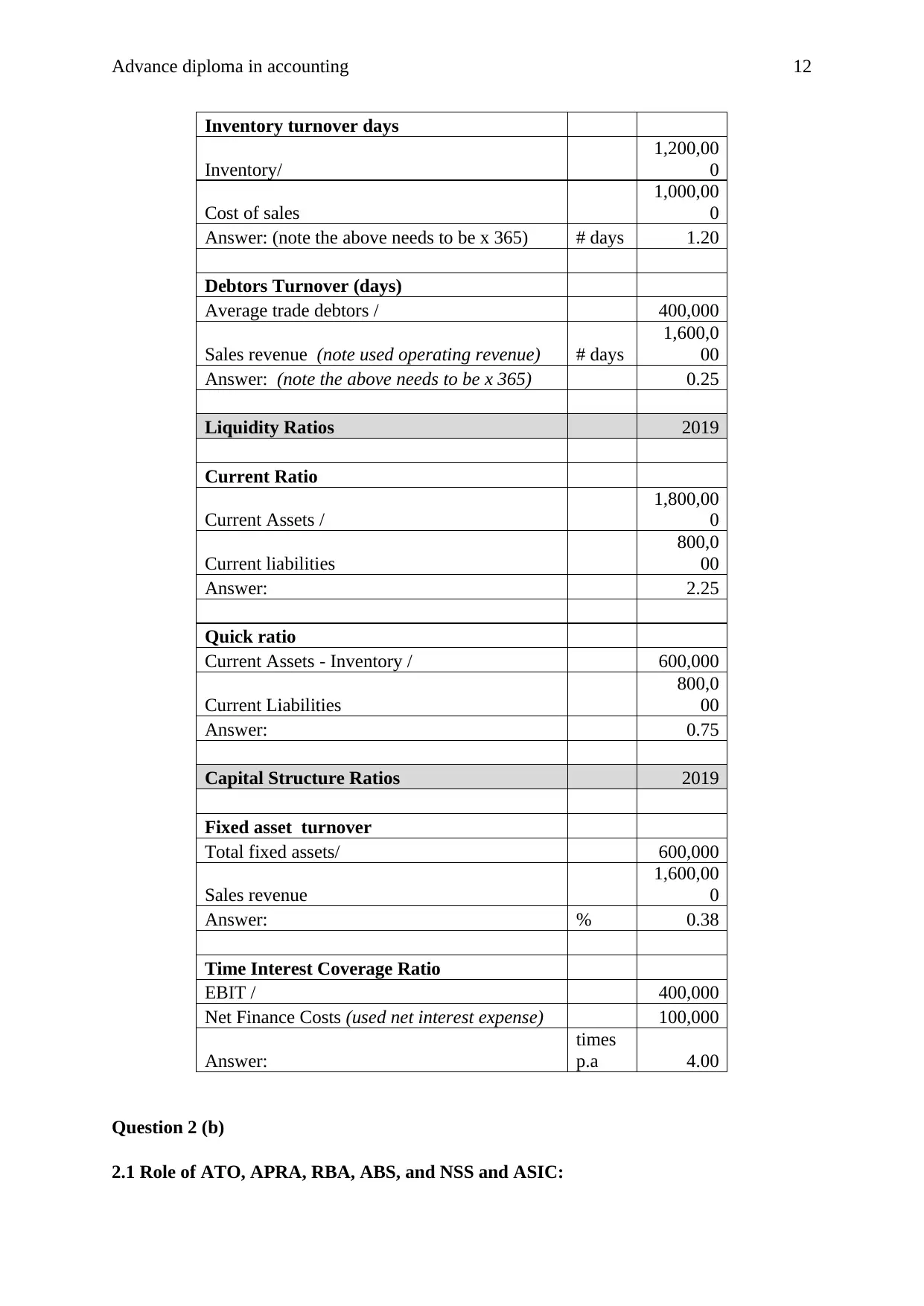
Advance diploma in accounting 12
Inventory turnover days
Inventory/
1,200,00
0
Cost of sales
1,000,00
0
Answer: (note the above needs to be x 365) # days 1.20
Debtors Turnover (days)
Average trade debtors / 400,000
Sales revenue (note used operating revenue) # days
1,600,0
00
Answer: (note the above needs to be x 365) 0.25
Liquidity Ratios 2019
Current Ratio
Current Assets /
1,800,00
0
Current liabilities
800,0
00
Answer: 2.25
Quick ratio
Current Assets - Inventory / 600,000
Current Liabilities
800,0
00
Answer: 0.75
Capital Structure Ratios 2019
Fixed asset turnover
Total fixed assets/ 600,000
Sales revenue
1,600,00
0
Answer: % 0.38
Time Interest Coverage Ratio
EBIT / 400,000
Net Finance Costs (used net interest expense) 100,000
Answer:
times
p.a 4.00
Question 2 (b)
2.1 Role of ATO, APRA, RBA, ABS, and NSS and ASIC:
Inventory turnover days
Inventory/
1,200,00
0
Cost of sales
1,000,00
0
Answer: (note the above needs to be x 365) # days 1.20
Debtors Turnover (days)
Average trade debtors / 400,000
Sales revenue (note used operating revenue) # days
1,600,0
00
Answer: (note the above needs to be x 365) 0.25
Liquidity Ratios 2019
Current Ratio
Current Assets /
1,800,00
0
Current liabilities
800,0
00
Answer: 2.25
Quick ratio
Current Assets - Inventory / 600,000
Current Liabilities
800,0
00
Answer: 0.75
Capital Structure Ratios 2019
Fixed asset turnover
Total fixed assets/ 600,000
Sales revenue
1,600,00
0
Answer: % 0.38
Time Interest Coverage Ratio
EBIT / 400,000
Net Finance Costs (used net interest expense) 100,000
Answer:
times
p.a 4.00
Question 2 (b)
2.1 Role of ATO, APRA, RBA, ABS, and NSS and ASIC:
⊘ This is a preview!⊘
Do you want full access?
Subscribe today to unlock all pages.

Trusted by 1+ million students worldwide
1 out of 20
Related Documents
Your All-in-One AI-Powered Toolkit for Academic Success.
+13062052269
info@desklib.com
Available 24*7 on WhatsApp / Email
![[object Object]](/_next/static/media/star-bottom.7253800d.svg)
Unlock your academic potential
Copyright © 2020–2025 A2Z Services. All Rights Reserved. Developed and managed by ZUCOL.





